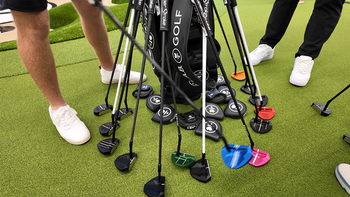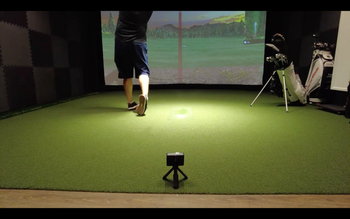A 56-degree wedge usually travels somewhere between 55 and 95 yards, but that number changes based on how well you strike it and your experience level. Exceptional players who shoot around par typically send it 75-95 yards, weekend warriors see it go 65-85 yards, and folks still learning the game get about 55-75 yards.
While your swing speed is the biggest factor, the ball you're playing, what Mother Nature's doing, and whether the course is hard or soft all make a difference in your carry distance. Nail down your fundamentals, and you'll know exactly what number to expect when you pull this club.
Breaking Down Distance by Player Type
Figuring out your sand wedge yardage starts with being honest about where your game sits right now. Let me tell you - there's a huge gap between what a single-digit player hits versus someone shooting in the 90s.
Skilled golfers who've been at this for years send their sand wedges 75-95 yards since they've built up serious clubhead speed and know how to catch it pure. Players in the middle range hit theirs about 65-85 yards, which shows they're making good contact most of the time. Still working on your swing? You're looking at 55-75 yards - and hey, that's perfectly fine!
Check your scorecard average, and it'll tell you everything. Better players create more speed and strike it cleaner, while higher handicappers often see less consistency in both areas. Tour pros hit way different numbers than weekend players, even when their swing speeds match up - it's all about that crispy contact and polished mechanics. What's interesting is the yardage difference between good and average players shrinks way down with wedges versus something like a 5-iron.

What Makes Your Sand Wedge Go Far (Or Not)
Getting the right yardage from your sand wedge involves way more than just swinging harder - there's actually a bunch of stuff happening that affects where your ball ends up. Sure, clubhead speed's significant, but here's what really matters: a smooth, controlled motion beats trying to kill it any day. Hit that sweet spot and you'll get all the energy from your swing going right into the ball.
Your golf ball choice makes a bigger difference than you'd think. Faster swingers get more out of firm, high-compression balls, but softer ones give most of us better touch around the greens. Weather changes everything too - a helping breeze adds yards while fighting into wind steals them away. Hot days let your ball fly longer since warm air's less dense, but cold mornings keep everything shorter.
Don't forget what's under your feet either. Clean lies on tight fairways let you make perfect contact, while soggy conditions mean the club digs and you lose serious distance. Your playing ability sets realistic expectations too - average players hit it around 80 yards while Tour guys average 124 yards.
Where Your Sand Wedge Fits with Your Other Short Clubs
Once you get how all these things affect your shots, you'll see exactly where your sand wedge belongs in your scoring club collection. Most golfers hit their 56-degree about 65-90 yards, which puts it smack in the middle of their wedge lineup. Check this out: pitching wedges go longest at 90-120 yards, gap wedges fill the middle at 80-110 yards, and lob wedges handle the short stuff at 45-80 yards.
Picture it like stairs going down - each wedge drops off roughly 10-15 yards from the one before it. That spacing gives you options for any distance inside 120 yards without having to manufacture weird half-swings. Understanding these numbers speeds up your decision-making and takes the mystery out of club selection. Your sand wedge becomes the perfect choice for those tweener shots where your gap wedge would sail long but your lob wedge comes up short. For best results, keep about 4-6 degrees between each wedge's loft so you don't have any big distance holes.
Getting More Yards with Better Form and Setup
The difference between a weak 60-yard shot and a pure 85-yarder that finds your target comes down to how you set up and swing. Stand a touch wider than you normally would - it'll keep you balanced when you really go after one. Put that ball slightly ahead of the middle to help launch it higher. The secret sauce? Keep your weight split evenly and maintain some flex in your knees the whole way through. Don't death-grip the handle either - hold it secure but relaxed. A sweeping motion through impact with good balance on your finish gets you max distance without losing control. Since your swing speed determines carry distance, work on consistent rhythm beats, trying to swing out of your shoes. Your sand wedge typically flies about 10 yards less than a gap wedge, which helps you understand how your wedges work together.
Fixing the Stuff That Costs You Distance

Ever wonder why your sand wedge keeps falling 10-15 yards short when you need it most? Usually, it's because of setup mistakes that are super easy to correct.
Start by checking how far you are from the ball. Get too cozy and you'll feel cramped, but reaching for it ruins your power. Your grip's vital too - if it's too weak, the face opens up and you'll lose 5-10 yards right there.
Listen, moving your weight correctly changes everything. Load up on your trail foot going back, then shift to your lead foot coming through. Skip this and you're giving away free distance. Bad timing from rushing wrecks your rhythm and costs you yards, too.
Always remember the conditions! Wind and hills can change your shot by more than 10 yards, so pick your club accordingly. Want consistent numbers? Measure your clubs correctly instead of propping them against something, which gives you wonky readings.
Frequently Asked Questions
Which Other Wedges Should I Bag with My Sand Wedge?
Pair your sand wedge with a pitching wedge somewhere between 46-48 degrees and grab a lob wedge around 60 degrees too. That combo fills all the gaps nicely! Your pitching wedge takes care of those longer approaches, the sand wedge owns everything in between plus bunker duty, and that lob wedge saves your bacon when you need to get it up quick. Three wedges like this handle pretty much any short game situation.
Is My Sand Wedge Good for Chips Near the Green?
Absolutely use that 56-degree for chipping! Set the ball back a bit, keep your hands forward through the strike, and make a nice easy swing. That loft pops it up nicely to clear fringe or rough before it lands soft. Works great from different lies around the green, usually going 10-30 yards with good control.
When's It Time for a New Sand Wedge?
Time for fresh grooves after about 60-70 rounds if you want it performing its best. Here's what happens - those grooves slowly wear smooth, killing your spin and feel near the green. Playing once a week? That's about two years before replacement time. Hit lots of bunker shots or practice constantly? You'll need a new one faster. Put your current wedge next to a brand new one - the performance gap's obvious!
What's the Right Bounce for My Swing Style?
Your swing tells you which bounce fits best on that sand wedge. Dig big divots with a steep attack? Get yourself 12-14 degrees of bounce so you don't stick in the turf. Sweep through impact without taking much grass? Lower bounce around 8-10 degrees suits you better. Most folks do great with 12 degrees since it handles different lies and swings pretty well.
Should New Golfers Get a Sand Wedge Right Away?
Hold off on the sand wedge and grab a pitching wedge or gap wedge first. Here's the deal: lower lofts mean simpler shots with flights you can predict. A pitching wedge (46-48 degrees) or gap wedge (50-52 degrees) stays lower and behaves better while you're learning. After you've got those dialed in and you're practicing short game regularly, then bring that 56-degree into your arsenal.
Conclusion
Now you've got everything to dial in those sand wedge numbers! Forget what the tour guys hit - your own consistent yardage is what counts. Work on solid strikes, good fundamentals, and steady rhythm instead of trying to smoke every wedge. Hit shots from different spots and conditions to build trust. Bottom line - quit worrying about other people's distances and lock in your own number for when it counts on the course.





